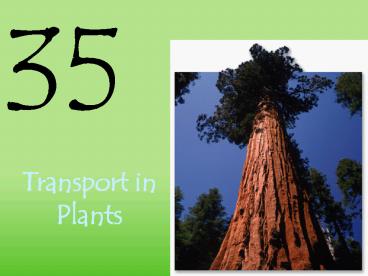Transport in Plants PowerPoint PPT Presentation
1 / 21
Title: Transport in Plants
1
Transport in Plants
35
2
- Terrestrial plants obtain water and mineral
nutrients from soil - Water needed for
- photosynthesis
- essential for transporting solutes up and down
- cooling plant
- internal pressure to support plant
- Plants lose large quantities of water to
evaporation, which must be replaced
www.eurekalert.org/features/kids/images
3
- Plants usually obtain water minerals from soil
via roots - Water uptake requires water to enter through cell
membranes via osmosis - Mineral uptake requires transport proteins
- Roots obtain carbohydrates and other materials
from leaves.
4
- Solute potential (aka. osmotic potential)
- Determines direction of water movement across
membrane - The greater the solute concentration of a
solution, the more negative the solute potential,
and - the greater the tendency for water to move into
it from another solution of lower solute
concentration
- i.e. water moves from low solute concentration
to higher solute conc.
5
Osmosis Modifies the Shapes of Cells
6
- Plants have rigid cell walls
- As water enters cell due to its negative solute
potential, - entry of more water is resisted by an opposing
pressure potential (turgor pressure). - Water enters plant cells until pressure potential
exactly balances solute potential - At this point the cell is turgid It has
significant positive pressure potential (but
balanced by turgor pressure)
www.botany.hawaii.edu/faculty/webb/BOT311/BOT311-0
0/Water
7
- Osmosis is extremely important to transport in
plants - Physical structure maintained by positive
pressure potential - Wilting is caused by loss of pressure potential
- Over long distances in xylem and phloem, flow of
water and dissolved solutes is driven by a
gradient of pressure potential
www.mun.ca/biology/singleton/Topic203
8
- Most of the ions in soil are lower in
concentration than required in the plant - Therefore, active transport must be used
- Unlike animals, plants dont have a sodium
potassium pump - Instead, they have a proton (H) pump
9
- Plants use proton pumps (requires ATP) to move
protons (H) out of cells against gradient - Accumulation of H outside cell results in
electrical gradient and concentration gradient
of protons - Inside of cell is now more negative than outside
- Cations (e.g. K) can move in by facilitated
diffusion
- - - - -
10
- Xylem transport
- Xylem vessels are dead and have no cell contents
? fused end to end forming long tubular straw
of lignified cell walls - Tallest trees exceed 110 meters xylem must
transport lots of water to great height - Several models for xylem transport have been
proposed
Photo 35.3 Trunk of coastal redwood (Sequoia
sempervirens).
11
How Are Water and Minerals Transported in the
Xylem?
- First proposal was pumping action by living
cells. - Ruled out in 1893 by classic experiment
- Cut trees were placed in poison solution
- Solution rose through trunk to leaves (which
died), then stopped rising - So, therefore, if cells at bottom were alive,
they would be killed and stop their pumping
action
X
12
- This experiment established three points
- Live, pumping cells were not involved
- Leaves were crucial solution continued to rise
until leaves were dead - Movement was not caused by roots
13
- Some hypothesized that xylem transport is based
on root pressure - Guttation shows that there is some root pressure
- However, water can still reach leaves when roots
are cut off
Root pressure also causes sap To ooze from cut
X
http//www.fz-juelich.de/icg/icg-iii/datapool/Proj
ektbilder/Frank.jpg
14
- Current model Alternative to pushing is pulling
- Transpirationcohesiontension mechanism
- Leaves pull xylem sap upwards
- Evaporative water loss from leaves creates
pulling force (tension) on water in apoplast of
leaves - Hydrogen bonding between water molecules makes
sap cohesive enough to withstand the tension and
rise by bulk flow
http//www.science-projects.com
15
Transpiration-Tension-Cohesion
- Concentration of water vapor in atmosphere is
lower than in leaf - Water vapor diffuses from leaf through the
stomata transpiration - Within leaf, water evaporates from walls of
mesophyll cells, film of water on cells shrinks ?
creating more surface tension (negative pressure
potential). - Draws more water into cell walls to replace what
was lost during transpiration - Resulting tension pulls water from xylem
- Water is drawn up from roots because of cohesion
16
- Leaf and stem epidermis has a waxy cuticle to
minimize water loss, but it also prevents gas
exchange - Stomata
- pores in leaf epidermis
- allow CO2 to enter by diffusion.
- Guard cells control opening and closing
17
- Most plants open stomata when light intensity is
enough for moderate rate of photosynthesis - At night, stomata remain closed
- CO2 not needed, and no water is lost
- During day, stomata close if water is being lost
too rapidly
http//www.colorado.edu/geography/class_homepages/
geog_3251_sum08/01_stomata.jpg
18
- Cues for stomatal opening include light, and
concentration of CO2 in intercellular spaces in
the leaf - Low CO2 levels favor opening of stomata
Photo 35.2 Wilting tomato shoot under water
stress
19
- Plants limit water loss by controlling stomata in
two ways - By regulating stomatal opening and closing
- By controlling the total number of stomata
- Trees can do this by losing some leaves.
- Other plants reduce the number of stomata on new
leaves - If Arabidopsis is exposed to high CO2 levels, new
leaves have fewer stomata than under normal
conditions.
http//www.colorado.edu/geography/class_homepages/
geog_3251_sum08/01_stomata.jpg
20
- Movement of carbohydrates and other solutes
through phloem is translocation ? move from
sources to sinks - Sources (e.g., leaves) produce more sugars than
they require - Sinks consume sugars for growth or storage (root,
flower, developing fruit)
www.botany.hawaii.edu/faculty/webb/BOT410/Phloem/
21
- In a classic experiment, a tree was girdled
- Ring of bark containing phloem was removed
- Organic solutes collect in phloem above girdle,
causing it to swell - Eventually bark, then roots below, and whole tree
die because sugars are not being translocated
downwards

